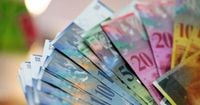On March 31, 2025, the Polish zloty is showing signs of strength against major currencies in the Forex market. According to the National Bank of Poland (NBP), the exchange rates for the day reflect notable movements. Specifically, 1 US dollar costs 3.86 PLN, 1 euro is valued at 4.18 PLN, 1 Swiss franc is priced at 4.38 PLN, and 1 British pound stands at 5.00 PLN. These figures indicate a slight fluctuation compared to previous rates, with the zloty gaining ground against its competitors.
The latest currency rates show a positive trend for the Polish zloty, as it appreciates against major currencies. The GBP/PLN pair has increased by 0.24%, the CHF/PLN by 0.06%, the USD/PLN by 0.12%, and the EUR/PLN by 0.13%. This trend suggests that the zloty is benefitting from a favorable market sentiment, despite ongoing global economic uncertainties.
Earlier in the week, the currency rates showed some instability. On March 28, 2025, the dollar was slightly higher at 3.88 PLN, while the euro remained stable at 4.18 PLN. The Swiss franc was trading at 4.40 PLN, and the British pound was at 5.03 PLN. These rates reflect the ongoing dynamics in the Forex market, influenced by various economic indicators and geopolitical events.
Looking back to March 27, the US dollar was at 3.89 PLN, the euro at 4.19 PLN, the Swiss franc at 4.40 PLN, and the British pound at 5.03 PLN. The fluctuations in these rates are driven by multiple factors, including supply and demand for each currency, central bank decisions on interest rates, macroeconomic data such as inflation and GDP, and geopolitical events that can affect investor sentiment.
As the market continues to react to these influences, the Polish zloty is attempting to maintain its position. On March 31, the dollar is fighting to hold at 3.86 PLN, while the euro has returned above 4.18 PLN. The Swiss franc is oscillating near 4.38 PLN, and the British pound is testing the critical barrier of 5 PLN.
The market is also preparing for upcoming changes, particularly on April 2, 2025, when mutual tariffs are expected to come into effect. These tariffs will impact major partners of the United States, including Canada, Mexico, the European Union, China, and India. The exact details of these tariffs remain unconfirmed, but they are intended to discourage aggressive trade policies towards the US and impose tariffs on the United States itself.
In addition to these developments, economic data from Poland and abroad will be closely monitored. Preliminary inflation data for March in Poland has been reported to hold steady at 4.9%. Investors will also be looking at retail sales and import price data from Germany, as well as inflation figures from Italy. For the British pound, attention will be on mortgage lending and M4 money supply data for February. Meanwhile, for the US dollar, important indicators such as the PMI index and the Dallas Fed index for March will be released, alongside any further actions from the Trump administration.
As of 10:00 AM on March 31, the currency rates are as follows: EUR/PLN at 4.1793, USD/PLN at 3.8617, GBP/PLN at 5.0051, and CHF/PLN at 4.3854. These rates indicate the ongoing fluctuations in the Forex market as traders react to the latest economic news.
The fluctuations in currency rates are not just numbers; they reflect the broader economic landscape. For instance, the rise in demand for the US dollar can elevate its value against other currencies, while seasonal factors like holidays or year-end can also impact exchange rates. Investors in the Forex market must stay informed about these dynamics to make educated trading decisions.
In conclusion, the Polish zloty has shown resilience against major currencies as of March 31, 2025. The ongoing fluctuations in currency rates are influenced by a complex interplay of economic indicators, geopolitical events, and market sentiment. As traders prepare for the upcoming week, the anticipation of new economic data and policy changes will likely contribute to further volatility in the Forex market.




![Aktualne kursy walut [31.03.2025]. Polski złoty wciąż trzyma się mocno](https://thumbor.evrimagaci.org/Eoh_My5pLNDmiwrgg_8xpU7vOQc=/200x0/tpg%2Fsources%2F7a640fb0-53bc-4ed1-abf8-aee2cbccd290.jpeg)



